Permaculture companion plants for Black mulberry
| Image | Name | Data | Description | Actions |
|---|---|---|---|---|

|
Chives |
3-12
Full sun, Partial sun/shade
Moist
Light (sandy), Medium, Heavy (clay)
6.0-7.0
0.3
0.45
Perennial
Herbs
Medium
8-12inches
Seed - direct sow, Seed - transplant, Division
4-6 weeks before last frost
14-21 days
21°c (70°f)
antifungal, Dynamic accumulator, Ground cover, Fragrance
true
Flowers, Leaves, Root
Wild chives, Flowering onion
Schnittlauch
Alliaceae
Allium
Afghanistan, Alaska, Albania, Alberta, Altay, Austria, Baltic States, Belarus, British Columbia, Bulgaria, Buryatiya, Central European Rus, Chita, Colorado, Connecticut, Corse, Czechoslovakia, Denmark, East European Russia, Finland, France, Germany, Great Britain, Greece, Idaho, Iran, Iraq, Irkutsk, Italy, Japan, Kamchatka, Kazakhstan, Khabarovsk, Korea, Krasnoyarsk, Kuril Is., Labrador, Magadan, Maine, Manitoba, Massachusetts, Michigan, Minnesota, Mongolia, Montana, Netherlands, New Brunswick, New Hampshire, New Jersey, New York, North Caucasus, North European Russi, Northwest European R, Northwest Territorie, Norway, Nova Scotia, Nunavut, Ohio, Ontario, Oregon, Pakistan, Pennsylvania, Poland, Portugal, Primorye, Prince Edward I., Québec, Rhode I., Romania, Sakhalin, Saskatchewan, South European Russi, Spain, Sweden, Switzerland, Tadzhikistan, Transcaucasus, Turkey, Tuva, Ukraine, Vermont, Washington, West Himalaya, West Siberia, Wisconsin, Wyoming, Xinjiang, Yakutskiya, Yugoslavia, Yukon
Argentina South, Azores, Belgium, Comoros, Cuba, Dominican Republic, Falkland Is., Haiti, Illinois, Ireland, Jamaica, Maryland, Newfoundland, Seychelles, Trinidad-Tobago
https://en.wikipedia.org/wiki/Chives
https://pfaf.org/User/Plant.aspx?LatinName=Allium schoenoprasum
https://powo.science.kew.org/taxon/urn:lsid:ipni.org:names:528823-1
|
Chives (Allium schoenoprasum) are a bulb-forming herbaceous perennial plants that belong to the same family as onions, garlic, and leeks. They are native to Europe, Asia, and North America, and are commonly grown in gardens for their delicate onion flavor and attractive purple flowers. Chives are easy to grow and require little maintenance. They can be grown in pots or containers, or directly in the ground. The plants have thin, hollow leaves that grow in tight clumps and reach a height of around 12-20 inches (30-50 cm). The bulbs are slender, conical, 2–3 cm (3⁄4–1 1⁄4 in) long and 1 cm (1⁄2 in) broad, and grow in dense clusters from the roots. The scapes (or stems) are hollow and tubular, up to 50 cm (20 in) long and 2–3 mm (1⁄16–1⁄8 in) across, with a soft texture, although, prior to the emergence of a flower, they may appear stiffer than usual. The grass-like leaves, which are shorter than the scapes, are also hollow and tubular, or terete, (round in cross-section) which distinguishes it at a glance from garlic chives (Allium tuberosum). The flowers are pale purple, and star-shaped with six petals, 1–2 cm (1⁄2–3⁄4 in) wide, and produced in a dense inflorescence of 10-30 together; before opening, the inflorescence is surrounded by a papery bract. The seeds are produced in a small, three-valved capsule, maturing in summer. The herb flowers from April to May in the southern parts of its habitat zones and in June in the northern parts. Chives are often used as a seasoning in a variety of dishes, including soups, omelets, and dips. They can also be added to melted butter to make a simple but flavorful sauce for steamed vegetables. Chives are low in calories and a good source of vitamin C, making them a healthy addition to any diet. |
Show
Edit |
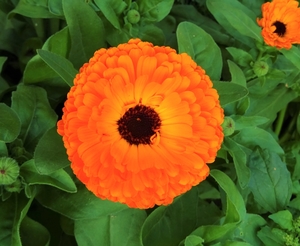
|
Pot marigold |
2-11
Full sun, Partial sun/shade
Moist
Light (sandy), Medium, Heavy (clay)
5.5-7.0
0.6
0.3
Annual
Medium
15cm
6-14 days
21°c (70°f)
60
Compost, Cosmetic, Dye, Essential Oil, Weather forecasting, Dynamic accumulator, Fragrance
Flowers, Leaves
Calendula, Common marigold, Scotch marigold, Ruddles
Ringelblume
Asteraceae or compositae
Spain
Afghanistan, Albania, Argentina Northeast, Argentina Northwest, Argentina South, Assam, Austria, Azores, Baleares, Baltic States, Belarus, Belgium, Bolivia, Borneo, British Columbia, Bulgaria, California, Canary Is., Central European Rus, Chatham Is., Chile Central, Chile North, Chile South, China North-Central, China South-Central, China Southeast, Colombia, Connecticut, Cook Is., Corse, Costa Rica, Cyprus, Czechoslovakia, East Aegean Is., East European Russia, East Himalaya, Ecuador, Ethiopia, France, Germany, Great Britain, Greece, Guatemala, Hainan, Honduras, Hungary, India, Iraq, Ireland, Italy, Jawa, Juan Fernández Is., Kazakhstan, Kriti, Krym, Lebanon-Syria, Lesser Sunda Is., Libya, Madeira, Maine, Malaya, Manchuria, Massachusetts, Mauritius, Mexico Southeast, Michigan, Morocco, Myanmar, Nepal, Netherlands, New Hampshire, New South Wales, New York, New Zealand North, New Zealand South, Newfoundland, North Caucasus, North European Russi, Northern Territory, Northwest European R, Norway, Nova Scotia, Ohio, Ontario, Pakistan, Paraguay, Pennsylvania, Peru, Philippines, Poland, Portugal, Primorye, Qinghai, Queensland, Québec, Romania, Sardegna, Sicilia, South Australia, South European Russi, Sulawesi, Sumatera, Sweden, Switzerland, Tadzhikistan, Taiwan, Tasmania, Tibet, Transcaucasus, Trinidad-Tobago, Turkey, Turkmenistan, Ukraine, Uruguay, Uzbekistan, Victoria, Vietnam, Washington, Western Australia, Wisconsin, Xinjiang, Yugoslavia
https://en.wikipedia.org/wiki/Calendula_officinalis
https://pfaf.org/User/Plant.aspx?LatinName=Calendula officinalis
https://powo.science.kew.org/taxon/urn:lsid:ipni.org:names:187894-1
4.6
Colouring, Tea
true
|
The pot marigold, also known as Calendula officinalis, is a flowering plant probably native to southwestern Asia, western Europe, and the Mediterranean region, however, its long cultivation history makes its precise origin unknown. It is a herbaceous annual plant that typically grows to be about 12-18 inches tall, with hairy stems and leaves. The leaves are lance-shaped, with a hairy surface, and the flowers can range in colour from white through yellow and orange to red and even pink. In terms of growing conditions, the pot marigold prefers well-drained soil and full sun, although it can tolerate partial shade. It is winter hardy, but may not flower as profusely in colder climates. To cultivate it successfully, a grower should plant pot marigold seeds directly in the ground after the last frost of the season. The pot marigold has a number of uses, both culinary and medicinal. The flowers are edible and can be used to add color and flavor to salads and other dishes. The petals can also be dried and used to make tea. In terms of medicinal uses, the plant has been used for centuries to treat a variety of ailments, including wounds, infections, and skin irritation. The pot marigold is also attractive to a variety of pollinators, making it a valuable plant for attracting beneficial insects to the garden. Overall, the pot marigold is a versatile and easy-to-grow plant that is well-suited to a variety of garden settings. ### Propagation - Direct sow Direct sow in spring when light frost is still possible. Can be sown until early summer for fall blooms. ### Propagation - Transplant Sow indoors in late winter, transplant outside when risk of heavy frost has passed. #### Links [Calendula @ West Coast Seeds](https://www.westcoastseeds.com/products/zeolights-organic) |
Show
Edit |

|
Garlic |
3-10
Perennial
Full sun
Dry, Moist
Light (sandy), Medium
0.6
Herbs
Flowers, Leaves, Root, Seed
Seed - direct sow
https://en.wikipedia.org/wiki/Garlic
Cultivated garlic
Alliaceae
Knoblauch
20cm
https://pfaf.org/User/Plant.aspx?LatinName=Allium sativum
6.5-7.0
Sting and itch relief from insect bites
Fibrous
Shallow
100-150
Allium
Iran, Kazakhstan, Kirgizstan, Tadzhikistan, Turkmenistan, Uzbekistan
Albania, Algeria, Amur, Austria, Baleares, Baltic States, Bangladesh, Belarus, Bulgaria, Cambodia, Canary Is., Central European Rus, China North-Central, China South-Central, China Southeast, Corse, Cuba, Czechoslovakia, Dominican Republic, East European Russia, Egypt, Ethiopia, France, Galápagos, Germany, Greece, Haiti, Hungary, Illinois, India, Iraq, Italy, Jamaica, Kentucky, Korea, Leeward Is., Libya, Mexico Central, Mexico Northwest, Mexico Southeast, Mexico Southwest, Morocco, New York, North European Russi, Northwest European R, Pakistan, Poland, Primorye, Puerto Rico, Romania, Sardegna, Seychelles, Sicilia, South European Russi, Spain, Switzerland, Tennessee, Thailand, Trinidad-Tobago, Tunisia, Turkey, Ukraine, Vermont, Wisconsin, Yugoslavia
Late autumn, Early spring
https://powo.science.kew.org/taxon/urn:lsid:ipni.org:names:528796-1
Adhesive, antifungal, Dynamic accumulator
true
|
Garlic (Allium sativum) is a bulbous perennial plant in the family Amaryllidaceae. It is native to central Asia and northeastern Iran, and has long been a staple in cuisines around the world. The plant has a distinctive appearance, with narrow, long leaves and a tall, hollow stem. The leaves are a pale green color and are attached to the stem in a spiral arrangement. The flowers are small and white, and are clustered in a spherical head at the top of the stem. Garlic plants can grow to a height of 30-150 cm (12-59 in), depending on the variety. They are relatively fast-growing plants, with the bulbs maturing in about seven months. Mulch for proper overwintering when planted in autumn. Garlic can be differentiated from other plants in the Allium genus by its distinctive flavor and aroma. It is also often distinguished by its long, narrow leaves and tall, hollow stem. Garlic prefers well-drained soil and full sun, and is typically grown from bulbs. To cultivate garlic successfully, growers should plant the bulbs in the fall, about 6-8 weeks before the first frost. The bulbs should be spaced about 10-15 cm (4-6 in) apart, with the pointed end facing up. After planting, the bulbs should be watered regularly and mulched to protect them from cold temperatures. Garlic is edible, with the bulbs and leaves being the most commonly eaten parts of the plant. The bulbs can be used fresh or cooked, and are often used as a seasoning in a wide variety of dishes. The leaves can be used fresh or cooked, and have a milder flavor than the bulbs. To harvest dig and do not pull out the bulbs. Let them dry in an airy, shady and dry spot e.g. by hanging them up. Once wrappers are dry, it can be stored at a dry place for several months. In addition to its culinary uses, garlic has a number of other uses. It is commonly used medicinally, as it has been shown to have antimicrobial and anti-inflammatory properties. It is also sometimes used as a natural insect repellent. In the garden, it can be used as a natural fertilizer, as it is believed to improve the soil and help deter pests. Garlic has value for wildlife, as it is attractive to a wide variety of pollinators, including bees, butterflies, and hummingbirds. It is also a food source for animals such as rabbits and deer. |
Show
Edit |
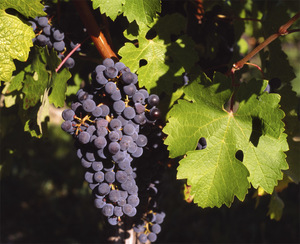
|
Common Grape Vine |
6-10
Perennial
Full sun, Partial sun/shade
Dry, Moist
Light (sandy), Medium, Heavy (clay)
Deciduous
15-32m
Vines
True
Flowers, Fruit, Leaves, Seed
Seed - direct sow, Cuttings
https://en.wikipedia.org/wiki/Vitis_vinifera
Fast
Wine grape, Purpleleaf grape, Common grape, Angur, Diva loza, Grozde yagorida, Tumpeang ba'y chu, Uva, Vid, Vigne, Vino, Weinrebe, Aanab, Ainab, Aitoviiniköynnös, Lehti, Angoor, Angur, Blad från vinranka, Bortermo szolo levél, Cognac oil, Common grape vine, Dakh, Darakh, Drakh, Draksa, Draksh, Draksha, Draksha kottai, Draksha pondu, Drakshai, Drakya, Dry grapes, Drak?a (fruit), European grape, Feuille de vigne rouge, Folha de videira, Frunze de vita-de-vie, Gostani, Gostoni, Grape, Grape seeds oligomeric proanthocyanidins, Grape vine, Grapevine, Grapevine leaf, Kashmish, Kishmish, Kottai drakshai, Lambrusca, Lambrusque, Lie de vin, List vinica, List vinske trte, Lisc winorosli wlasciwej, Maneka, Maweez munaqqa, Maweezak kohi, Munaca, Munaqqa, Munkka, Munthringya, M?dvika, Parra, Raisins, Rote weinrebenblätter, Rød vinranke, Blad, Tikruju vynmedžiu lapai, Vid, Hoja de, Vigne, Vigne rouge, Vigne vinifère, Viinapuu lehed, Vinblad, Vine, Vinho, Vino, Vite, Foglia, Vitis vinifera, Flos, Vitis viniferae folium, Vínviðarlauf, Weinrebe, Werqa tad-dielja, Wijnstokblad, Wine, Wine grape, Zabeeb-ul-jabal, Cervený list vinné révy, Ista vinkoka lapas
Vitaceae
Weintraube
Oil
https://pfaf.org/user/plant.aspx?latinname=Vitis+Vinifera
Southern Europe, Central Europe, Southwestern asia , Albania, Austria, Bulgaria, Corse, Cyprus, Czechoslovakia, France, Germany, Greece, Hungary, Iran, Iraq, Italy, Kirgizstan, Krym, Lebanon-Syria, North Caucasus, Palestine, Romania, Sardegna, Sicilia, Switzerland, Tadzhikistan, Transcaucasus, Turkey, Turkey-in-Europe, Turkmenistan, Ukraine, Uzbekistan, Yugoslavia
4.3-8.6
Tap
0.6-6m
8feet
6 weeks
20°c (69°f)
12 months
False
Druif
Vindrue
Afghanistan, Algeria, Angola, Argentina Northeast, Azores, Baleares, Bangladesh, Belgium, British Columbia, California, Canary Is., Cape Verde, Caroline Is., Chad, China North-Central, China South-Central, China Southeast, East Aegean Is., East European Russia, East Himalaya, Easter Is., Ecuador, Eritrea, Ethiopia, Gulf of Guinea Is., Idaho, India, Kazakhstan, Korea, Kriti, Laos, Libya, Madeira, Massachusetts, Morocco, New Hampshire, New York, New Zealand North, Oregon, Pakistan, Pennsylvania, Peru, Poland, Portugal, South European Russi, Spain, Tibet, Trinidad-Tobago, Tunisia, Vietnam, Washington, West Himalaya
https://powo.science.kew.org/taxon/urn:lsid:ipni.org:names:30478388-2
1
|
This is the common grape which has a lot of varieties but only a few are grown (commercially). Common Grape Vine (Vitis vinifera) is a species of grapevine native to the Mediterranean region, central Europe, and southwestern Asia. It is a woody perennial vine that grows to a length of 20-30 feet when supported by a trellis or other structure. The leaves are dark green and palmately lobed, with five to nine leaflets. The flowers are small and greenish-white, and are produced in clusters. The fruit is a berry, typically blue or purple in color, and is edible. In terms of growth and cultivation, Common Grape Vine prefers full sun and well-draining soil. It can be grown from cuttings or from grape seeds, and should be trained to a trellis or other support structure. In order to produce fruit, the plant must be cross-pollinated with another grapevine of a different variety. The fruit is typically harvested in the late summer or early fall. The edible fruit of the Common Grape Vine can be eaten fresh or used to make wine, juice, and other products. The fruit can be stored by freezing or canning. The leaves can also be eaten, and are commonly used in dishes such as dolma. In addition to its edible fruit, the Common Grape Vine has several other uses. The leaves can be used as a source of natural dye, and the wood can be used for fuel or to make furniture and other items. The plant also provides habitat and food for a variety of wildlife, including birds and small mammals. Fruits are used to be eaten fresh or used for producing juice, wine or vinegar. Raisins are made out of dried grapes. Leaves and flowers can be eaten too. Seeds are used to produce oil. # Propagation While propagation from seed is possible, propagating from cuttings or grafting is way more common and simple. |
Show
Edit |
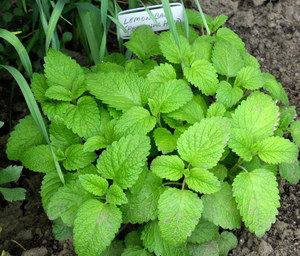
|
Lemon balm |
4-8
Full sun, Partial sun/shade
Dry, Moist
Light (sandy), Medium
0.7
Perennial
Herbs
Fast
45cm
true
Leaves
Balm, common balm, balm mit, bee balm, sweet balm
Zitronenmelisse
Lamiaceae or labiatae
Albania, Algeria, Baleares, Bulgaria, Corse, Cyprus, East Aegean Is., France, Greece, Iran, Iraq, Italy, Kirgizstan, Kriti, Lebanon-Syria, Morocco, North Caucasus, Palestine, Portugal, Sardegna, Sicilia, Spain, Tadzhikistan, Transcaucasus, Tunisia, Turkey, Turkey-in-Europe, Turkmenistan, Uzbekistan, Yugoslavia
Alabama, Argentina Northeast, Argentina Northwest, Argentina South, Arkansas, Austria, Azores, Belgium, British Columbia, California, Canary Is., Chile Central, Connecticut, Czechoslovakia, Delaware, Denmark, District of Columbia, Georgia, Germany, Great Britain, Hungary, Idaho, Illinois, Indiana, Ireland, Juan Fernández Is., Kansas, Kentucky, Krym, Louisiana, Madeira, Maine, Manitoba, Maryland, Massachusetts, Michigan, Missouri, Montana, Netherlands, New Jersey, New York, New Zealand North, New Zealand South, North Carolina, Ohio, Oklahoma, Ontario, Oregon, Pennsylvania, Poland, Québec, Rhode I., Romania, South Carolina, South European Russi, Sweden, Switzerland, Tasmania, Tennessee, Ukraine, Uruguay, Vermont, Virginia, Washington, West Siberia, West Virginia
https://en.wikipedia.org/wiki/Lemon_balm
https://pfaf.org/User/Plant.aspx?LatinName=Melissa officinalis
https://powo.science.kew.org/taxon/urn:lsid:ipni.org:names:450084-1
Weed potential
No
Light
Condiment, Tea
Essential Oil, Fragrance, Dynamic accumulator
|
Lemon balm (Melissa officinalis) is a perennial herb in the mint family. It is native to the Mediterranean region, but can now be found in many parts of the world. The plant has a bushy, upright habit and can grow up to 3 feet tall. It has oval-shaped leaves that are about 2-3 inches long and have a lemon scent when crushed. The leaves are a bright green color and are slightly serrated on the edges. The plant produces small, white or pale yellow flowers that bloom in the summer. Lemon balm prefers well-drained soil and full sun to partial shade. It is relatively easy to grow and can be propagated by dividing the root ball or by taking stem cuttings. It is important to give the plant enough space to grow, as it can spread rapidly. To prevent the plant from becoming invasive, it is a good idea to regularly deadhead the flowers and trim back the stems. Lemon balm can be used in cooking and is often added to salads or used as a garnish. The leaves can also be used to make tea or added to drinks and desserts for a lemony flavor. Lemon balm is also used in traditional medicine, as it is believed to have calming and soothing effects. In the garden, lemon balm can be used as a companion plant to repel pests and attract beneficial insects. The plant is also a good source of nectar for bees and other pollinators. Overall, lemon balm is a useful and versatile herb that can be enjoyed in the kitchen and the garden. |
Show
Edit |

|
White Mustard |
https://en.wikipedia.org/wiki/White_mustard
true
Fast
Moist
Full sun, Partial sun/shade
5-9
Light (sandy), Medium, Heavy (clay)
Brassicaceae or cruciferae
0.6
Weißer senf
Leaves, Seed
Oil, Condiment
Annual
https://pfaf.org/User/Plant.aspx?LatinName=Sinapis alba
5.2
Afghanistan, Albania, Algeria, Altay, Austria, Baleares, Baltic States, Belarus, Belgium, Bulgaria, Central European Rus, China North-Central, China South-Central, China Southeast, Corse, Cyprus, Denmark, East Aegean Is., East European Russia, France, Greece, Hungary, India, Iran, Iraq, Italy, Krasnoyarsk, Kriti, Krym, Laos, Lebanon-Syria, Libya, Manchuria, Morocco, Netherlands, North Caucasus, Northwest European R, Norway, Palestine, Portugal, Qinghai, Romania, Sardegna, Saudi Arabia, Sicilia, South European Russi, Spain, Sweden, Switzerland, Transcaucasus, Tunisia, Turkey, Turkey-in-Europe, Turkmenistan, Tuva, Ukraine, Uzbekistan, Vietnam, West Himalaya, West Siberia, Xinjiang, Yugoslavia
Alabama, Alberta, Amur, Argentina Northeast, Argentina South, Arizona, Azores, Bangladesh, British Columbia, California, Canary Is., Cape Provinces, Chita, Colombia, Colorado, Connecticut, Czechoslovakia, Delaware, District of Columbia, Egypt, El Salvador, Finland, Føroyar, Germany, Great Britain, Greenland, Gulf of Guinea Is., Iceland, Illinois, Indiana, Iowa, Ireland, Irkutsk, Japan, Leeward Is., Madeira, Maine, Manitoba, Marianas, Maryland, Massachusetts, Minnesota, Missouri, Montana, Nebraska, New Brunswick, New Hampshire, New Jersey, New Mexico, New South Wales, New York, North Carolina, North Dakota, North European Russi, Nova Scotia, Ohio, Oklahoma, Ontario, Oregon, Pennsylvania, Poland, Primorye, Prince Edward I., Puerto Rico, Queensland, Québec, Rhode I., Saskatchewan, South Carolina, South Dakota, Tadzhikistan, Tasmania, Tennessee, Texas, Utah, Vermont, Victoria, Washington, West Virginia, Windward Is., Wisconsin, Yakutskiya, Yukon
https://powo.science.kew.org/taxon/urn:lsid:ipni.org:names:288952-1
Cover crop, oil
|
Show
Edit |
|
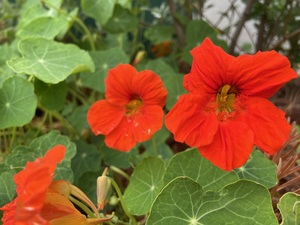
|
Nasturtium |
6-11
Full sun
Moist
Light (sandy), Medium
3.5
1
Annual, Perennial
Ground cover, Herbs
Fast
15cm
Seed - direct sow, Seed - transplant
1 week after last frost - late spring
2-4 weeks before last frost
2 weeks after last frost
7-12 days
12-18°C (55-65°F)
Pest control, oil, Fragrance
Flowers, Leaves, Seed, Seedpod
Oil, Condiment
Tropaeolum, Indian Cress
Große Kapuzinerkresse
Tropaeolaceae
Peru
Albania, Algeria, Amsterdam-St.Paul Is, Angola, Argentina Northeast, Ascension, Assam, Azores, Baleares, Bangladesh, Belgium, Bermuda, Bolivia, Brazil South, Brazil Southeast, Bulgaria, California, Cameroon, Canary Is., Cape Verde, Central European Rus, Chile Central, China South-Central, Colombia, Connecticut, Costa Rica, Cuba, Czechoslovakia, Dominican Republic, East Aegean Is., East Himalaya, Ecuador, El Salvador, Eritrea, Ethiopia, France, Free State, Great Britain, Greece, Guatemala, Haiti, Hawaii, Honduras, Jamaica, Juan Fernández Is., Korea, Kriti, Lebanon-Syria, Madeira, Massachusetts, Mauritius, Mexico Central, Mexico Northwest, Morocco, New Hampshire, New York, New Zealand North, New Zealand South, Norfolk Is., North European Russi, Oregon, Pennsylvania, Puerto Rico, Romania, Rwanda, Réunion, South European Russi, Spain, St.Helena, Tasmania, Tibet, Trinidad-Tobago, Tristan da Cunha, Tunisia, Uruguay, Vietnam, Zaïre
https://en.wikipedia.org/wiki/Tropaeolum_majus
https://pfaf.org/User/Plant.aspx?LatinName=Tropaeolum majus
https://powo.science.kew.org/taxon/urn:lsid:ipni.org:names:310974-2
true
|
Tropaeolum majus, commonly known as garden nasturtium, is a flowering plant that is native to South and Central America and can be grown annually as well as perennially. It belongs to the family Tropaeolaceae, which includes around 80 species of plants. T. majus is a popular garden plant, known for its bright, colorful flowers and attractive foliage. The flowers are typically yellow, orange, or red and have a distinctive, trumpet-like shape. The leaves are rounded and have a slightly waxy texture, and the plant produces long, trailing stems that can be used to create a cascading effect in hanging baskets or other containers. To grow T. majus, it is best to start the seeds directly in the ground or in pots after the last frost has passed. The plant prefers well-drained soil and full sun, but can also tolerate partial shade. It is important to water the plants regularly, but avoid overwatering, as this can cause the leaves to rot. T. majus can also be grown in containers and trained to climb trellises or other structures. In addition to its ornamental value, T. majus is also edible. The leaves, flowers, and seeds can be used in salads and other dishes, adding a slightly spicy, peppery flavor. The plant has also been used medicinally, as the leaves and seeds contain compounds with antibacterial and antioxidant properties. T. majus has been used to treat a variety of ailments, including respiratory infections and digestive disorders. It has also been used as a natural remedy for urinary tract infections and kidney stones. However, T. majus should be used with caution, as it can cause allergic reactions in some people. Additionally, T. majus can become invasive if allowed to spread, so gardeners should take care to keep it contained. #### Links [Nasturtium @ West Coast Seeds](https://www.westcoastseeds.com/products/jewel-mix ) |
Show
Edit |

|
Beta vulgaris cicla |
4-8
Biennial
Full sun
Moist
Light (sandy), Medium, Heavy (clay)
0.9
true
Leaves, Stem
Chenopodiaceae
Swiss chard, silver beet, perpetual spinach, beet spinach, seakale beet, leaf beet
Mangold, krautstiel
https://pfaf.org/User/Plant.aspx?LatinName=Beta vulgaris cicla
2-3 years
|
Leaf vegetable. Leaves and stalks are edible. Closely related to the beet. |
Show
Edit |
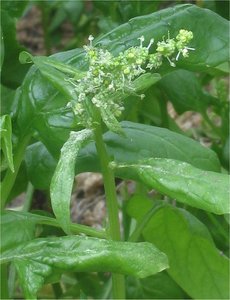
|
Spinach |
4-8
Full sun, Partial sun/shade
Moist
Light (sandy), Medium, Heavy (clay)
0.3
0.3
Annual
Herbs
Fast
Seed - direct sow, Seed - transplant
3 weeks prior to last frost date
2 weeks
Leaves, Seed
Spinat
Chenopodiaceae
Altay, Kazakhstan, Turkmenistan, Uzbekistan
Afghanistan, Algeria, Amur, Bangladesh, California, Canary Is., Cayman Is., Connecticut, Czechoslovakia, Denmark, Dominican Republic, East Aegean Is., Greece, Haiti, India, Inner Mongolia, Iran, Japan, Korea, Kriti, Laos, Lebanon-Syria, Libya, Maine, Marianas, Massachusetts, Morocco, New Hampshire, New York, North Carolina, Norway, Ohio, Oregon, Pakistan, Pennsylvania, Primorye, Rhode I., Saudi Arabia, South Carolina, Sweden, Tadzhikistan, Tunisia, Vietnam, Virginia, Washington, Yemen
https://en.wikipedia.org/wiki/Spinach
https://pfaf.org/User/Plant.aspx?LatinName=Spinacia oleracea
https://powo.science.kew.org/taxon/urn:lsid:ipni.org:names:167384-1
from March to June; Aug to Sep
start seeds indoors 8 weeks prior to last frost date
carminative, laxative, hypoglycaemic; against inflammation
Colouring
Dye
true
|
Spinach (Spinacia oleracea) is a leafy green vegetable native to central and southwestern Asia. The plant has smooth, glossy, and dark green leaves that are arranged in a rosette pattern. It has a long, thick stem that is typically green or red in color, depending on the variety. The plant grows to a height of 6-8 inches and produces small, inconspicuous flowers. Spinach grows best in cool, moist conditions and prefers full sun or partial shade. To cultivate it successfully, the soil should be well-draining and rich in organic matter. The plant can be grown from seed and is typically ready for harvest in about 50-60 days. Successional sowing once per month/every two weeks is recommended for continuous supply. Spinach is highly nutritious and is a good source of vitamins A, C, and K, as well as calcium, potassium, and iron. The edible parts of the plant include the leaves and stems, which can be eaten fresh or cooked. Spinach should be stored in the refrigerator and used within a few days of harvest to maximize its nutritional value. In addition to its culinary uses, spinach has been used medicinally to treat a variety of conditions, including anemia, high blood pressure, and inflammation. The plant can also be used as a fertilizer, as its leaves are rich in nitrogen and other nutrients. Spinach can provide valuable habitat and food for a variety of wildlife, including birds and insects. |
Show
Edit |
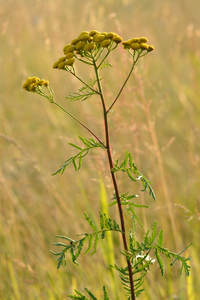
|
Tansy |
3-8
Full sun
Dry, Moist
Light (sandy), Medium, Heavy (clay)
1.0
0.5
Perennial
Herbs
Fast
true
Flowers, Leaves
Common tansy, golden buttons, curly leaf tansy
Rainfarn
Asteraceae or compositae
Albania, Altay, Amur, Austria, Baltic States, Belarus, Belgium, Bulgaria, Buryatiya, Central European Rus, Chita, Corse, Czechoslovakia, Denmark, East European Russia, Finland, France, Germany, Great Britain, Greece, Hungary, Inner Mongolia, Irkutsk, Italy, Japan, Kamchatka, Kazakhstan, Khabarovsk, Kirgizstan, Korea, Krasnoyarsk, Krym, Kuril Is., Magadan, Manchuria, Mongolia, Netherlands, North Caucasus, North European Russi, Northwest European R, Norway, Poland, Portugal, Primorye, Romania, Sakhalin, Sicilia, South European Russi, Spain, Sweden, Switzerland, Transcaucasus, Turkey, Turkey-in-Europe, Tuva, Ukraine, West Siberia, Xinjiang, Yakutskiya, Yugoslavia
Alaska, Alberta, Arizona, Arkansas, Bolivia, Brazil North, Brazil Northeast, Brazil South, Brazil Southeast, Brazil West-Central, British Columbia, California, Colombia, Colorado, Connecticut, Cook Is., Ecuador, Føroyar, Georgia, Iceland, Idaho, Illinois, Indiana, Iowa, Ireland, Kansas, Kentucky, Labrador, Louisiana, Maine, Manitoba, Maryland, Massachusetts, Mauritius, Michigan, Minnesota, Missouri, Montana, Nebraska, Nevada, New Brunswick, New Hampshire, New Jersey, New Mexico, New South Wales, New York, Newfoundland, North Carolina, North Dakota, Northwest Territorie, Nova Scotia, Ohio, Oklahoma, Ontario, Oregon, Panamá, Paraguay, Pennsylvania, Peru, Prince Edward I., Queensland, Québec, Rhode I., Réunion, Saskatchewan, South Australia, South Dakota, Tasmania, Tennessee, Trinidad-Tobago, Tubuai Is., Uruguay, Utah, Venezuela, Vermont, Victoria, Virginia, Washington, West Virginia, Wisconsin, Wyoming
https://en.wikipedia.org/wiki/Tansy
https://pfaf.org/User/Plant.aspx?LatinName=Tanacetum vulgare
https://powo.science.kew.org/taxon/urn:lsid:ipni.org:names:252568-1
0.2
Weed potential
Condiment, Tea
Compost, Dye, Essential Oil, Pest control, Strewing, Dynamic accumulator, Fragrance
|
Show
Edit |
|
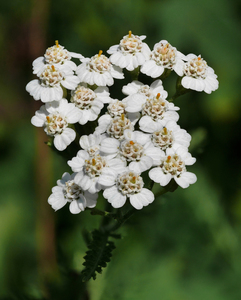
|
Yarrow |
4-8
Perennial
Full sun, Partial sun/shade
Dry, Moist
Light (sandy), Medium, Heavy (clay)
0.6
Herbs
true
Leaves
https://en.wikipedia.org/wiki/Achillea_millefolium
Fast
Boreal yarrow, california yarrow, giant yarrow, coast yarrow, western yarrow, pacific yarrow, bloodwort, carpenter's weed, common yarrow, hierba de las cortaduras, milfoil, plumajillo
Asteraceae or compositae
Gemeine schafgarbe
Weed potential
https://pfaf.org/User/Plant.aspx?LatinName=Achillea millefolium
0.2
Afghanistan, Alabama, Alaska, Albania, Alberta, Altay, Amur, Arizona, Arkansas, Austria, Baltic States, Belarus, Belgium, British Columbia, Bulgaria, Buryatiya, California, Central European Rus, Chita, Colorado, Connecticut, Czechoslovakia, Delaware, Denmark, District of Columbia, East European Russia, East Himalaya, Finland, Florida, France, Føroyar, Georgia, Germany, Great Britain, Greece, Greenland, Guatemala, Hungary, Iceland, Idaho, Illinois, Indiana, Iowa, Iran, Iraq, Ireland, Irkutsk, Italy, Kamchatka, Kansas, Kazakhstan, Kentucky, Khabarovsk, Kirgizstan, Krasnoyarsk, Krym, Kuril Is., Labrador, Lebanon-Syria, Louisiana, Magadan, Maine, Manitoba, Maryland, Massachusetts, Mexico Central, Mexico Gulf, Mexico Northeast, Mexico Northwest, Mexico Southeast, Mexico Southwest, Michigan, Minnesota, Mississippi, Missouri, Mongolia, Montana, Nebraska, Netherlands, Nevada, New Brunswick, New Hampshire, New Jersey, New Mexico, New York, Newfoundland, North Carolina, North Caucasus, North Dakota, North European Russi, Northwest European R, Northwest Territorie, Norway, Nova Scotia, Nunavut, Ohio, Oklahoma, Ontario, Oregon, Pakistan, Pennsylvania, Poland, Portugal, Primorye, Prince Edward I., Québec, Rhode I., Romania, Sakhalin, Sardegna, Saskatchewan, Sicilia, South Carolina, South Dakota, South European Russi, Spain, Sweden, Switzerland, Tadzhikistan, Tennessee, Texas, Transcaucasus, Turkey, Turkey-in-Europe, Turkmenistan, Tuva, Ukraine, Utah, Uzbekistan, Vermont, Virginia, Washington, West Himalaya, West Siberia, West Virginia, Wisconsin, Wyoming, Yakutskiya, Yugoslavia, Yukon
Antipodean Is., Argentina Northeast, Argentina Northwest, Argentina South, Azores, Baleares, Bolivia, Borneo, Botswana, Brazil North, Brazil Northeast, Brazil South, Brazil Southeast, Brazil West-Central, Cameroon, Cape Provinces, Chatham Is., Chile Central, Chile North, Chile South, Colombia, Corse, Costa Rica, Cuba, Cyprus, Dominican Republic, Ecuador, Falkland Is., Free State, Haiti, Hawaii, Honduras, India, Inner Mongolia, Jamaica, Japan, Jawa, Korea, KwaZulu-Natal, Lesotho, Madeira, Malaya, Namibia, New South Wales, New Zealand North, New Zealand South, Nicaragua, Northern Provinces, Northern Territory, Paraguay, Peru, Philippines, Queensland, South Australia, South Georgia, Sulawesi, Sumatera, Taiwan, Tasmania, Uruguay, Victoria, Vietnam, Western Australia, Xinjiang, Zimbabwe
https://powo.science.kew.org/taxon/urn:lsid:ipni.org:names:2294-2
Condiment, Tea
Companion, Compost, Cosmetic, Dye, Essential Oil, Hair, Animal feed, Dynamic accumulator, Ground cover, Fragrance
|
Yarrow (Achillea millefolium) is a perennial plant that is native to temperate regions of the Northern Hemisphere, including Europe, Asia, and North America. It is commonly found in meadows, grasslands, and along roadsides. Yarrow has fern-like leaves that are divided into many narrow, tooth-like segments. The leaves are typically dark green in color and grow in a basal rosette. The plant produces small, white or pink flowers that are arranged in compact, flat-topped clusters. The flowers are attractive to pollinators such as bees and butterflies. Yarrow typically grows to a height of 30-90 cm (12-36 in) and has a spreading habit. It is a fast-growing plant that can quickly colonize an area through its rhizomatous root system. Yarrow is often differentiated from similar plants by its strongly scented leaves and its distinctive flower clusters. Yarrow prefers well-drained soils and full sun to partial shade. It is drought-tolerant and can grow in a variety of soil types, including sandy, loamy, and clay soils. To cultivate yarrow successfully, it is important to space the plants adequately to allow for good air circulation and to prevent the spread of diseases. Yarrow can also be propagated through dividing the root crowns or by planting seeds. Some parts of yarrow, such as the leaves and flowers, are edible and can be used in salads or as a garnish. The leaves have a slightly bitter, astringent flavor and can be used fresh or dried. The flowers can also be used to make tea. It is important to note that some people may experience allergic reactions to yarrow, so it is best to try a small amount first before consuming it in larger quantities. Yarrow has a long history of use in traditional medicine, where it has been used to treat a wide range of ailments, including wounds, infections, and fevers. It is also believed to have anti-inflammatory and astringent properties. In the garden, yarrow can be used as a natural insect repellent, as a mulch to suppress weeds, and as a companion plant to improve the health and vigor of other plants. Yarrow is valuable to wildlife as a nectar and pollen source for pollinators. It also provides shelter and habitat for beneficial insects, such as ladybugs and lacewings, which help to control pest populations in the garden. Overall, yarrow is a versatile and useful plant that can add beauty and functionality to a garden or farm. |
Show
Edit |
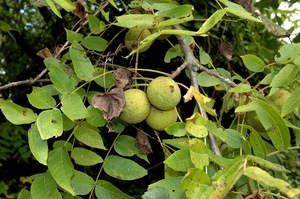
|
Black walnut |
4-9
Perennial
Full sun
Moist
Light (sandy), Medium, Heavy (clay)
30.0
Tall trees
Crafting, Compost, Dye, Filter, Herbicide, Pest control, oil, Tannin, Lumber, Dynamic accumulator, Fragrance
true
Sap, Seed
https://en.wikipedia.org/wiki/Juglans_nigra
Fast
Juglandaceae
Schwarznuss
True
Oil, Sweetener
https://pfaf.org/User/Plant.aspx?LatinName=Juglans nigra
Alabama, Arkansas, Connecticut, Delaware, District of Columbia, Florida, Georgia, Illinois, Indiana, Iowa, Kansas, Kentucky, Louisiana, Maryland, Massachusetts, Michigan, Minnesota, Mississippi, Missouri, Nebraska, New Jersey, New York, North Carolina, Ohio, Oklahoma, Ontario, Pennsylvania, Rhode I., South Carolina, South Dakota, Tennessee, Texas, Virginia, West Virginia, Wisconsin
Austria, Belgium, Bulgaria, Czechoslovakia, Denmark, Germany, Hungary, Italy, New Mexico, North Caucasus, Poland, Romania, Tadzhikistan, Transcaucasus, Vermont, West Himalaya
https://powo.science.kew.org/taxon/urn:lsid:ipni.org:names:279034-2
|
Black walnut is a large deciduous tree native to North America, growing up to 100 feet tall. It has a straight trunk with a rough, deeply furrowed bark, and a canopy of large, pinnately compound leaves with 15-23 lance-shaped leaflets. The tree produces large, greenish-white flowers in the spring, followed by large, spherical fruits containing a single, edible nut. Black walnuts are prized for their distinctive, rich flavor and are commonly used in baking and cooking. The nuts can be harvested in the fall and can be stored in their shells for several months. Black walnuts prefer deep, well-drained soils and can tolerate a wide range of soil pH levels. They can be grown successfully in full sun to partial shade, and they are relatively drought-tolerant once established. Black walnuts are not particularly winter hardy, and they can be damaged by heavy ice and snow. In addition to their culinary uses, black walnuts have a number of other uses. The wood is highly prized for its durability and attractive grain, and is used in furniture making and other woodworking applications. The tree's leaves, bark, and nuts are also used in herbal medicine for their astringent and tonic properties. Black walnuts are also valued for their ability to improve soil health, as their deep taproots help to break up compacted soils and their fallen leaves add organic matter to the soil. Black walnuts are also an important food source for wildlife, including squirrels, birds, and deer. The tree provides shelter and nesting sites for a variety of animals, and its fallen leaves and nuts provide food for many species. |
Show
Edit |
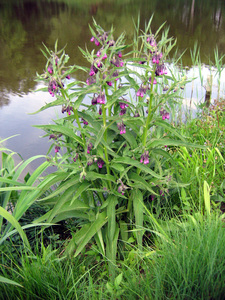
|
Comfrey |
3-9
Perennial
Full sun, Partial sun/shade
Moist
Light (sandy), Medium, Heavy (clay)
1.2
Herbs
true
Leaves, Shoots
https://en.wikipedia.org/wiki/Symphytum_officinale
Fast
Common comfrey, Comfrey, Symphytum
Boraginaceae
https://pfaf.org/User/Plant.aspx?LatinName=Symphytum officinale
Gewone smeerwortel
Lægekulsukker
Altay, Austria, Belarus, Belgium, Bulgaria, Central European Rus, Czechoslovakia, East European Russia, France, Germany, Great Britain, Hungary, Italy, Kazakhstan, Krym, Netherlands, North Caucasus, Northwest European R, Poland, Romania, Sardegna, Sicilia, South European Russi, Spain, Switzerland, Turkey, Turkey-in-Europe, Ukraine, West Siberia, Yugoslavia
Alberta, Argentina Northeast, Arkansas, Baltic States, Brazil West-Central, British Columbia, California, China North-Central, China Southeast, Chita, Colorado, Connecticut, Delaware, Denmark, District of Columbia, Dominican Republic, Finland, Georgia, Haiti, Idaho, Illinois, Indiana, Ireland, Kentucky, Korea, Maine, Manchuria, Manitoba, Maryland, Massachusetts, Michigan, Minnesota, Missouri, Montana, New Brunswick, New Hampshire, New Jersey, New Mexico, New York, Newfoundland, North Carolina, North European Russi, Norway, Nova Scotia, Ohio, Ontario, Oregon, Pennsylvania, Primorye, Québec, Rhode I., Saskatchewan, Sweden, Taiwan, Tasmania, Utah, Vermont, Vietnam, Virginia, Washington, West Virginia, Wisconsin, Wyoming, Xinjiang
Beinwell, Wallwurz, Beinwurz
60cm
https://powo.science.kew.org/taxon/urn:lsid:ipni.org:names:120815-1
Gum, Tea
Biomass, Compost, Gum, Dynamic accumulator
|
Comfrey (Symphytum officinale) is a perennial plant that is native to Europe and Asia. It belongs to the family Boraginaceae, which includes around 300 species of plants. Comfrey is a popular garden plant, known for its large, hairy leaves and bell-shaped, white or purple flowers. The plant has a sprawling growth habit and can reach a height of up to 3-4 feet. The leaves are large, oval-shaped, and covered in fine hairs, and the flowers are clustered in elongated spikes at the ends of the stems. To grow comfrey successfully, it is important to choose a location with well-drained, fertile soil and full sun or partial shade. The plant is tolerant of a wide range of soil conditions, but prefers moist, slightly acidic soil. Comfrey can also be grown in containers, and will benefit from regular watering and fertilization. The plant is relatively easy to grow and requires little maintenance, but can be susceptible to pests and diseases, such as slugs and fungal infections. Comfrey is not edible, and the leaves and roots of the plant contain toxic compounds that can cause irritation and allergic reactions in some people. However, the plant has a number of other uses, including medicinal and horticultural applications. The leaves and roots of the plant are high in nutrients, and are often used as a natural fertilizer for plants. The leaves can also be used to make a medicinal tea, and have been used to treat a variety of ailments, including wounds, bruises, and respiratory disorders. Comfrey is also a valuable food source for many types of wildlife, including bees, butterflies, and other pollinators. The flowers attract a wide range of insects, and the leaves and roots are eaten by animals such as rabbits and deer. The plant can spread rapidly and is considered invasive in some areas. |
Show
Edit |